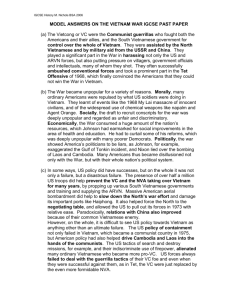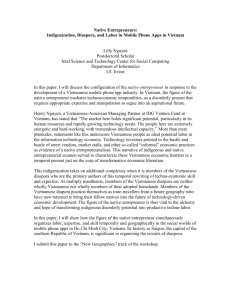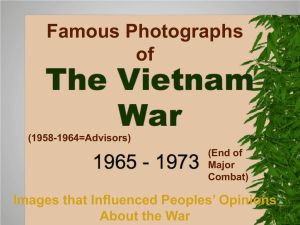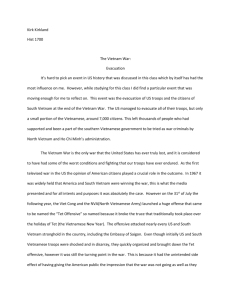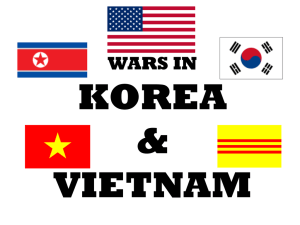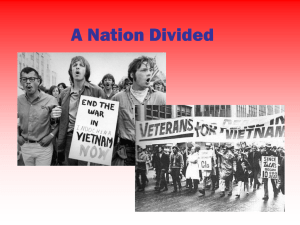Vietnamese History: Before the French
advertisement
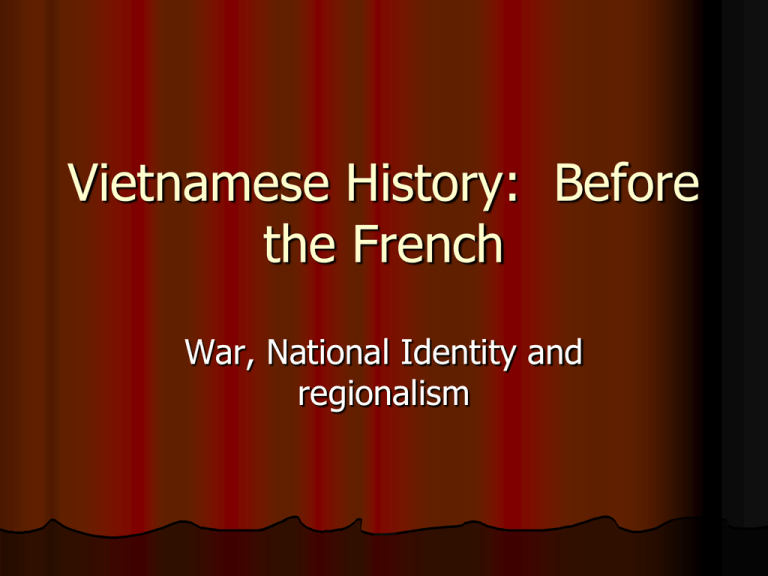
Vietnamese History: Before the French War, National Identity and regionalism Broad Themes – and Paradoxes - in Vietnam’s history 1.) Spirit of resistance – toward outside forces and conquerors (coupled with a willingness to use foreign assistance against rivals) 2.) Internal Divisions – regional divisions, dynastic rivalries (coupled with a strong sense of being one people) 3.) Role of China – cultural model, political foe (a love/hate relationships, with periods of great cooperation and times of conflict) China and Vietnam: The Most “Sinicized” Country of Southeast Asia Nam Viet Founded by Trieu Da in 208 B.C. Initially independent, but conquered by the Han emperor Wu Ti in 111 B.C. Within Chinese sphere of influence – literature, arts, religions (Confucianism, Buddhism, and Taoism) agricultural techniques – particularly the cultivation of rice – faced resistance and rebellions – the Trung sisters, 39 A.D. Major Vietnamese Dynasties Ngo Dynasty (939-967) – Founding Dynasty – named the country Dai Viet Dinh (968-980) – negotiated tributary relationship with China Tien Le (980-1009) Ly (1009-1225) – flourishing of Buddhism, capital moved to Hanoi, in 1075 first examinations held, revival of Confucianism Tran (1225-1400) – continued expansion in population and territory Vietnamese Dynasties Ho (1400-1428) – defeated by Ming dynasty – Chinese occupation Le (1428-1776) – Le Loi defeated the Chinese, (using guerilla tactics) renewed expansion to the South and defeated Champa – but rivals divided the country in the 16th and 17th century – sought aid from Portuguese, Dutch, French, and Chinese in their struggles – relative decline in midst of internal fighting Tayson Rebellion 177-1802 – divided Vietnam into three regions March to the South Dynastic Divisions Vietnam in the 17th century Effects of Expansion 1.) Destruction of the Champa 2.) Conflict with the Khmers 3.) Development of Regionalism 4.) Feuding Dynasties – frequent wars and divisions – Tayson Rebellions late 18th century 5.) Unity of the entire country under Nguyen Dynasty – 1802 – Emperor Gia Long – (helped by French military advisers) – moved capital to Hue – modeled upon the Chinese court in Beijing - lasts until 1883 Vietnamese language Alexander de Rhodes – 17th century Vietnam – Ethnic map Geographic areas Some thoughts on similarities between the US and Vietnam 1.) Both countries emerge out of colonial relationships – Vietnam with China, the US with Britain 2.) Both countries go through periods of expansion and fragmentation – the “March to the South” and “Manifest Destiny” – difference between North and South 3.) Both countries come to their national unity after wars and at roughly the same time – the US after the American Revolution in 1789, and Vietnam in 1802 after the Tayson Rebellions
![vietnam[1].](http://s2.studylib.net/store/data/005329784_1-42b2e9fc4f7c73463c31fd4de82c4fa3-300x300.png)
